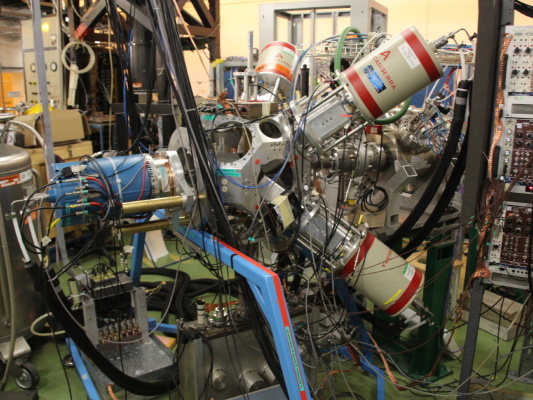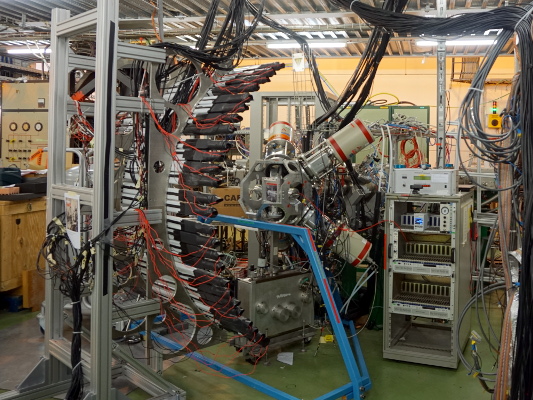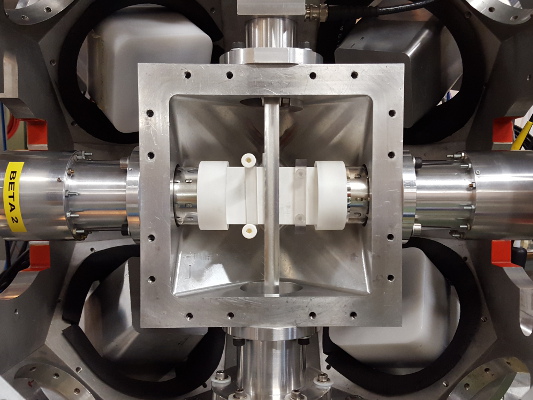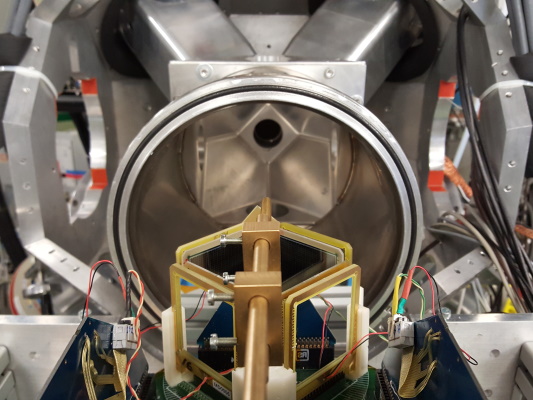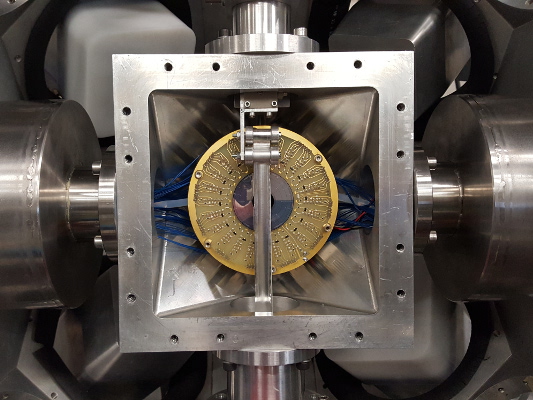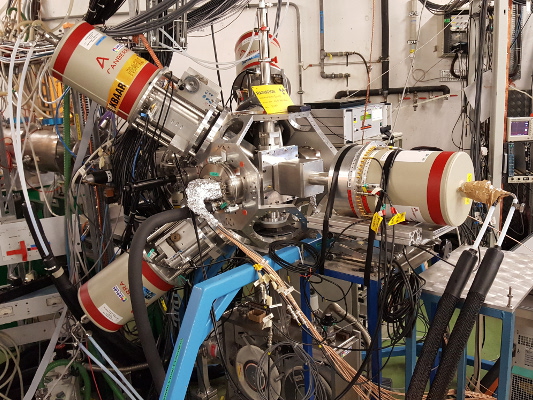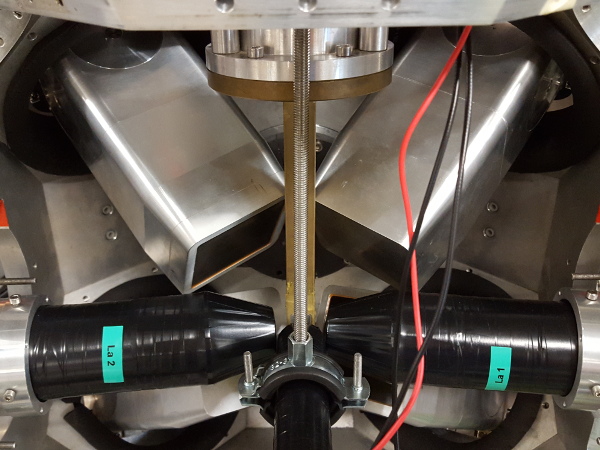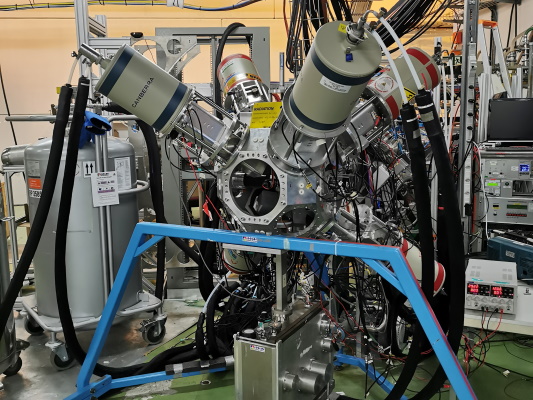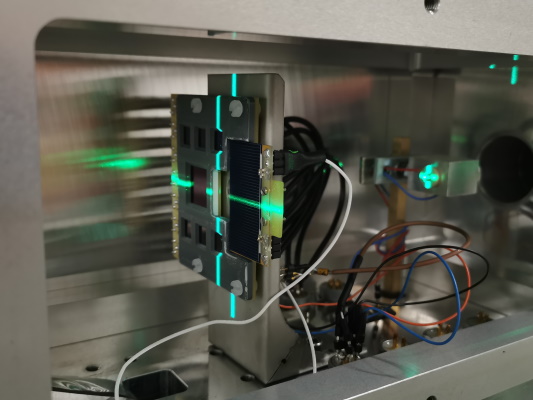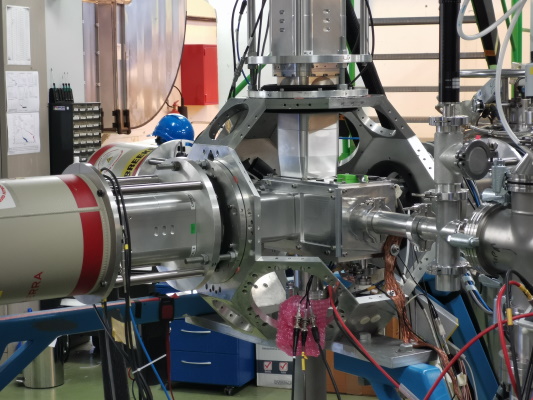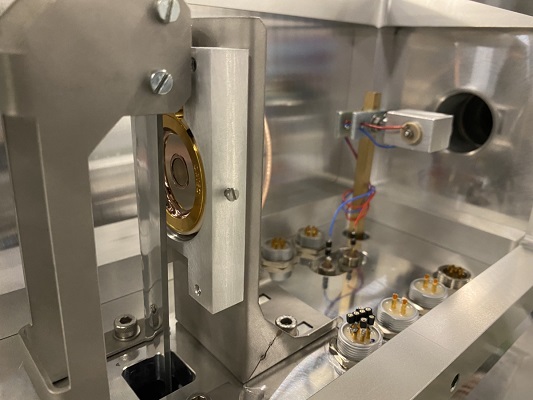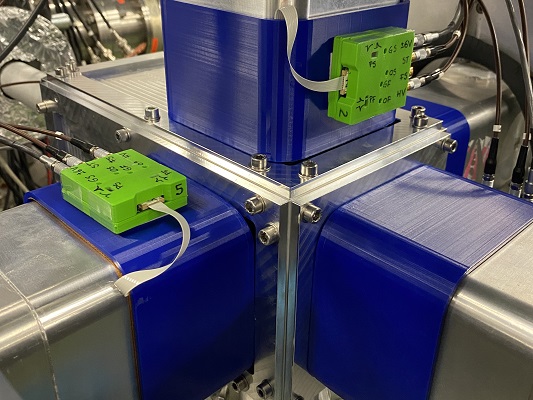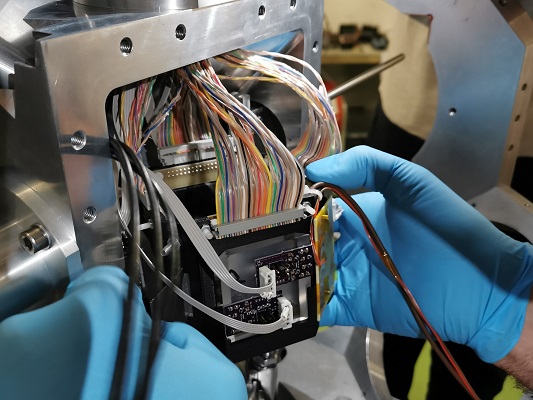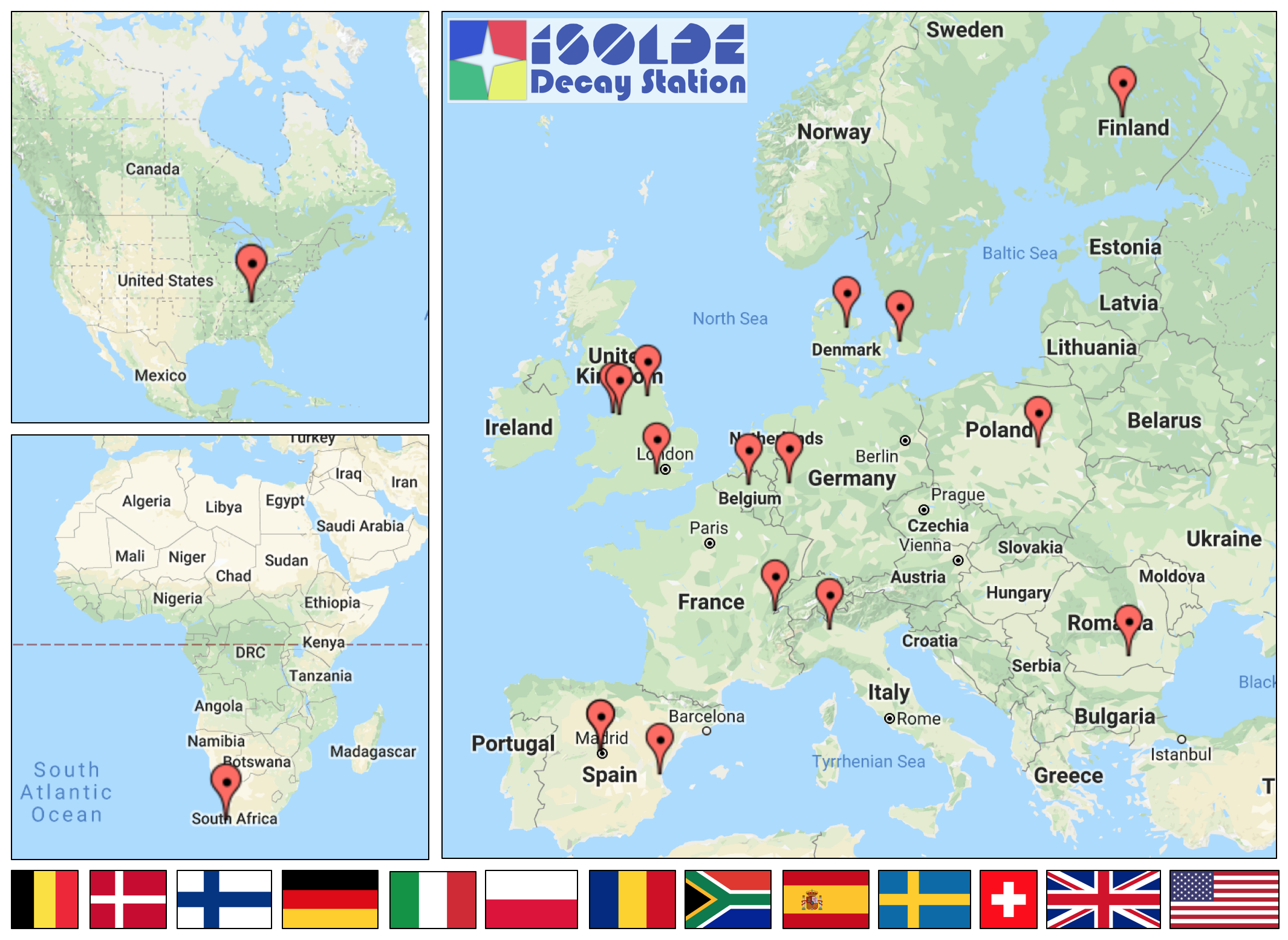ISOLDE Decay Station (IDS)
IDS is a permanent detector set-up at the ISOLDE facility at CERN, dedicated to decay spectroscopy for research into nuclear structure, nuclear engineering and astrophysics.
The versatile design of IDS allows for the installation of different types of detector around the implantation point, alongside its own four HPGe clovers. It can hence be used for many specialised decay measurements, including fast-timing, neutron time-of-flight, angular correlation, charged particle spectroscopy and conversion electron spectroscopy (using the newly employed SPEDE detector).
The Decay Station is an ideal tool for studying the decay properties of radioactive nuclei across the Segré chart; light to heavy, proton-rich to neutron-rich. The nucleus of interest is only limited by the production capabilities of the targets at ISOLDE.
Current capabilities
While the four HPGe clovers are used for most experiments at IDS, the addition of other HPGe detectors allows for increased statistics when performing gamma ray spectroscopy. Two openings in the holding structure (shell) at 90 degrees to the beamline, and a third located coaxially, in the horizontal plane may be used to position plastic beta detectors (two located here at IDS) or fast-timing detectors. The detector chamber itself may be changed according to the needs of the experiment, as may be the contents (such as DSSDs for particle detection). Since 2016, a dedicated neutron time-of-flight detector is permanently located at IDS (IDSND) and is based on the VANDLE (University of Tennessee, Knoxville, USA) detector design. Since 2018, the SPEDE Spectrometer is part of the IDS setup dedicated for conversion electron spectroscopy.
Basic arrangement
- IDS is at the end of the RC4 beamline, which can use the beam from either GPS (General Purpose Separator) or HRS (High Resolution Separator).
- The ions pass through a variable aperture collimator (2-10 mm) and are implanted on tape inside a vacuum chamber, positioned above the dedicated tape station. This tape may be moved automatically (in response to proton pulses from the PS Booster) or manually, depending on the desired implantation time.
- Four backward-facing high-purity germanium detectors, with LN2 cooling canisters, are evenly spaced azimuthally and point directly at the centre of the chamber. These may be inserted and retracted manually. Each consists of four HPGe crystals, giving IDS 16 crystals in total.
- Data is read through the dedicated NUTAQ digital acquisition system using the GREAT triggerless total data readout method.
New support structure (April 2023)
A new support structure was proposed at IDS during the December 2018 Collaboration meeting and installed in April 2023. The new support structure should accommodate the tapestation in the same position as before. Extra HPGe detectors (up to 15), or other types, can be installed on 5 support gantries able to hold 3 detectors each with the possibility to easily place the detectors at various angles and distances in a reproducible manner. The new frame will fit the existing Si plug-in and the INDiE setups and will effectively remove any extra material around the implantation chamber to limit the neutron scattering. It will also accommodate extra HPGe detectors (or other types) facing a second decay point, away from the implantation point, i.e. in-between the current implantation point and the tapestation.
IDS Detectors documentation:
- Canberra EUROBALL HPGe Clovers (Absolute Efficiency: 4 Clovers IS605, 4 Clovers IS605 (PRL), 4 Clovers IS579, 5 Clovers IS530, 6 Clovers IS622)
- Saint Gobain LaBr3(Ce) crystals and Hamamatsu (H10570) Photomultipliers (Absolute Efficiency: Different configurations, 1, 2)
- IDS Particle Spectroscopy setup using the MAGIsol DSSSD and electronics
- IDS Neutron detector (INDIE) array ( Absolute efficiency )
- SPEDE Spectrometer for conversion electron spectroscopy, EPJA 54:42 (2018) , ( Absolute Efficiency, Solid angle coverage, Spectrum )
- New SPEDE chamber design (2023, courtesy of designer Shaun Hendricks): 3D CAD model, youtube video of design
Collaborating institutes
IDS is supported by 19 institutes across the world, and used by many more globally.
List of core authors (2021-2023): .pdf
Past and future IDS meetings
Contact
Hilde De Witte (Resources Coordinator)
KU Leuven - Institute for Nuclear and Radiation Physics
Celestijnenlaan 200d - box 2418
3001 Leuven
Belgium
tel. +32 16327270
email: hilde.dewitte@kuleuven.be
James Cubiss (Collaboration Spokesperson)
School of Physics, Engineering and Technology - University of York
Heslington, York, YO10 5DD, U.K.
E-mail: james.cubiss@ed.ac.uk
Previous spokespersons:
Razvan Lica, IFIN-HH, Romania (2018 - 2022)
Piet Van Duppen, KUL, Belgium (2012 - 2018)
| Expt. | Spokesperson, institution | Beam | Description | Details | Publications |
|---|---|---|---|---|---|
| IS662 | R. Grzywacz, University of Tennessee, ORNL, Knoxville, USA | 134In | Beta-delayed neutron emission of 134In and search for i13/2 single particle neutron state in 134Sn using the IDS standard set
of 4 clover detectors, ~4% efficiency at 1 MeV, the IDS in-vacuum beta detector, 90% electron detection efficiency, and the newly commissioned IDS Neutron
DEtector (INDiE). The neutron detection will be enhanced by 15 NEXT neutron detector modules, which will have much higher
neutron energy resolution due to their segmentation and provide additional 3% neutron detection efficiency. These detectors are capable for neutron-gamma discrimination above
400 keV neutron energy, which is an added benefit for this measurement. These detectors will be operated at 50 cm TOF and will be placed on both sides of INDiE. Both detectors
have a neutron detection threshold of about 100 keV. 18 shifts.
18-24 May |
e-log proposal | |
| IS659 | H. Fynbo, Aarhus University, Aarhus, DK | 8He,9Li | Precise measurements of the β-decays of 9Li and 8He for reactor neutrino experiments requesting 10 shifts of beam time of 8He
produced from a CaO target, and 8 shifts of beam time of 9Li produced from a Ta target. The experiment will employ the IDS setup with the ISOLDE beam stopped in
a thin carbon foil surrounded by a compact setup of Double-Sided Silicon detectors. Neutrons will be measured with the INDiE array. 18 shifts.
1-6 June (9Li) |
e-log proposal | |
| I270 | J. R. Reilly, CERN, Geneva, CH | 34Mg | The use of in-trap decay as a beam production method at ISOLDE will be explored using the ISCOOL RFQ cooler-buncher to trap short-lived ions and
allow them to decay in-trap. This production method could provide future access to isotopes that are currently inaccessible at ISOLDE, such as the
refractory elements that cannot be extracted from the target and ion source. This study will explore how the different settings of the ISCOOL cooler-
buncher can be optimised for producing 34g,mAl and 34Si from 34Mg beams.6 shifts
12-13 Oct |
e-log proposal | |
| IS756 | J. G. Cubiss, University of York, York, UK | 209-212Hg | Decay, mass, and in-source laser spectroscopy measurements of the neutron-rich isotopes 209-212Hg, produced using a UCx
target with a quartz line. The region south-east of 208Pb that these isotopes inhabit is one of the most poorly studied in the nuclear
chart, due to the challenge in producing these nuclides. These isotopes are of interest for exploring how the influence of the Z=82 and N=126 shell
closures impacts the structures and properties of these nuclei, which in turn can place important constraints on models used in astrophysical
r-process network calculations. 21 shifts
24-30 Oct |
e-log proposal | |
| IS694 | N. Bernier, University of the Western Cape, SA | 80,82Y | Investigation of shape effects in 80,82Sr through the beta+/EC decay of 80,82Y and the measurement
of internal conversion electrons using the SPEDE electron spectrometer at IDS equipped with a tape station, four germanium clover
detectors, two LaBr3(Ce) detectors, and a fast plastic detector. 3 shifts
11-13 Nov |
e-log proposal | |
| IS741 | T. E. Cocolios, IKS-Leuven, Leuven, BE | 225Ac | 225Ac and 213Bi have been proposed as promising radioisotopes for targeted
alpha therapy against metastasised cancers. However, the accuracy and precision of the
knowledge of the decay properties of these isotopes and all those in their decay chain are
currently not sufficient to reliably use them for large-scale medical applications. In the
current proposal, we will measure the unique decay signatures of 225Ac, 221Fr, 213Bi and
209Tl using the ISOLDE Decay Station, thereby improving the knowledge of branching
ratios in the γ-ray emissions and the transition multipolarities of definitive γ-ray
cascades which are crucial nuclear data inputs required for the precise determination of
absolute activities of radioactive materials, and ultimately determine the personal
dosimetry during treatment. 1.5 shifts (out of 5.5 shifts)
2 Dec |
e-log proposal |
| Expt. | Spokesperson, institution | Beam | Description | Details | Publications |
|---|---|---|---|---|---|
| IS685 | L. M. Fraile, Universidad Complutense, Madrid, ES | 130-132Cd | We propose to use beta-decay and beta-n decay of neutron-rich Cd isotopes from a UCx target with a low-temperature quartz transfer line to populate
excited states in neutron-rich In (Z=49) isotopes at and around N=82. High-resolution γ-spectroscopy will be performed. The measurements will be complemented by excited-state
lifetime measurements using the fast-timing technique. Rescheduling of 2022 run that was affected by target problems. 12 shifts
17-21 May |
e-log proposal | |
| LOI244 | A. Andreyev, Univ. of York, UK | 209-216Hg | Development of the neutron-rich Hg beams from a UCx target with a low-temperature quartz transfer line and RILIS at ISOLDE. For the detection and identification of Hg isotopes the Isolde Decay Station (IDS) will
be used, equipped with the fast-timing configuration of IS685. 6 shifts
22-23 May |
e-log proposal |
| Expt. | Spokesperson, institution | Beam | Description | Details | Publications |
|---|---|---|---|---|---|
| IS685 | L. M. Fraile, Universidad Complutense, Madrid, ES | 130-132Cd | We propose to use beta-decay and beta-n decay of neutron-rich Cd isotopes to populate
excited states in neutron-rich In (Z=49) isotopes at and around N=82. High-resolution γ-spectroscopy will be performed. The measurements will be complemented by excited-state
lifetime measurements using the fast-timing technique. 12 shifts
8-12 Apr |
e-log proposal | |
| LOI219 | A. Gottardo, LNL-INFN, Legnaro, IT | 208-216Tl | Development of 208-216Tl beams, paving the way for future studies of
the structure of neutron-rich nuclei beyond 208Pb, by means of isomer and beta-decay spectroscopy at IDS.
Availability of Tl beams will also open the possibility for nuclear radii, moments and masses in this relatively unexplored region.9 shifts
21-25 Apr |
e-log proposal | PLB 849, 138452 (2024) PRC 110, 034315 (2024) |
| IS659 | H. Fynbo, Aarhus University, Aarhus, DK | 8He,9Li | Precise measurements of the β-decays of 9Li and 8He for reactor neutrino experiments requesting 10 shifts of beam time of 8He
produced from a CaO target, and 8 shifts of beam time of 9Li produced from a Ta target. The experiment will employ the IDS setup with the ISOLDE beam stopped in
a thin carbon foil surrounded by a compact setup of Double-Sided Silicon detectors. Neutrons will be measured with the INDiE array. 18 shifts.
12-15 May (8He) |
e-log proposal | |
| IS664 | R. Heinke, KUL, Leuven, BE | 230-231Ac | Investigation of octupole deformation in neutron-rich actinium using high-resolution in-source laser spectroscopy. The measurements will be achieved by using
a new operation mode of the LIST ion source. Detection of the ionization rate with respect to the laser frequency can be carried out for 230-231Ac using the ISOLDE Decay Station (IDS)
with a fast movable tape implantation point with an annular Si detector in front and plastic scintillators behind. 5 shifts.
26-30 May |
e-log proposal | |
| LOI216 | A. Andreyev, University of York, York, UK | 230-234Ac,Fr | Feasibility studies towards the systematic investigation of the beta-delayed fission in the even-A neutron-rich actinides. The experimental setup will be similar to INTC-P-558
with the option of installing an array of several solar cell detectors which are less sensitive to the radiation damage, in front of the implantation tape for measurement of
single alpha particles and fission fragments with geometric efficiencies of ~20% and of ~40%, respectively. 4 shifts.
26-30 May |
e-log proposal | |
| IS456 | T. Cocolios, KUL, Leuven, BE | 219-220Po | Study of ground-state and long-lived
isomeric-state properties in 211,212,219,220Po isotopes. To overcome preponderant isobaric Fr contamination, the RILIS in the LIST mode will be utilised. The new data will be used to
delineate the region of charge-radii odd-even staggering reversal for Z > 82, N > 126; to
study the properties of high-spin states with longer half-lives in the vicinity of N = 126;
and to study the systematic α-decay properties in neutron-rich pre-actinide nuclei to
test the nuclear models in the region. 9 shifts (IDS)
16-23 June |
e-log proposal | |
| IS622 | A. Illana, KUL, Leuven, BE | 74‑79Cu | The experiment will clarify and expand the level schemes and measure lifetimes of low-lying transitions in Zn isotopes ranging
from A=74 to A=79. Continuation of the 2018 and 2021 runs. 7 shifts
18-23 August |
e-log proposal |
| Expt. | Spokesperson, institution | Beam | Description | Details | Publications |
|---|---|---|---|---|---|
| IS622 | A. Illana, KUL, Leuven, BE | 74‑79Cu | The experiment will clarify and expand the level schemes and measure lifetimes of low-lying transitions in Zn isotopes ranging
from A=74 to A=79. It was performed with the upgraded fast-timing setup of IDS equipped with 6 Clover Germanium detectors, 3 LaBr3(Ce) detectors,
a fast plastic detector and in combination with the tape station. Despite the malfunction of the initial target that was expected to deliver
the neutron-rich Cu isotopes from the original proposal, we were offered an alternative target from which we extracted 181,183,184,185Tl and
performed fast-timing measurements for states in their daughter nuclei. 7 shifts to be reported. 7 shifts
16-19 July |
e-log proposal | |
| IS665 | B. Andel, KUL, Leuven, BE | 178,176,175Au | Laser assisted studies of beta-delayed fission in 178,176Au and of the structure of 175Au. A new implantation chamber was built
for this experiment, able to house a prototype alpha particle detector array comprised of Silicon Pin diodes in front of the implantation tape for detecting
both alpha particles and fission fragments with a geometric efficiency of ~5%. The chamber was surrounded by 4 HPGe Clover detectors placed in a cubic geometry,
two of them covered with the newly employed plastic scintillating pads read via SiPMs, acting as both beta-detectors and VETO detectors (for the corresponding
HPGe clover) that discriminate the background events originating from high-energy beta particles depositing their energy into the HPGe crystals. A complementary
setup named ASET, developed by KU Leuven, was installed at the travelling experiments beamline LA1, having an improved alpha detection efficiency (~50%) but with
reduced gamma efficiency and without a moving tape to remove the unwanted daughter activity. 14 shifts.
27 - 31 August |
e-log proposal |
| Expt. | Spokesperson, institution | Beam | Description | Details | Publications |
|---|---|---|---|---|---|
| IS633b | O. Tengblad, IEM-CSIC, Madrid, ES | 8B | Study of the decay of the proton halo nucleus 8B at IDS using the particle spectroscopy setup with the aim of determining
the beta strength for decays into highly excited states of 8Be, 8 shifts (LA1).
19 - 23 April |
e-log proposal | |
| IS622 | A. Illana, KUL, Leuven, BE | 74‑79Cu | The experiment will clarify and expand the level schemes and measure lifetimes of low-lying transitions in Zn isotopes ranging
from A=74 to A=79. It will be performed with the fast-timing setup of IDS equipped with 4 Clover Germanium detectors, 2 LaBr3(Ce) detectors,
a fast plastic detector and in combination with the tape station, 19 shifts.
24 - 29 May |
e-log proposal | |
| IS610b | L. M. Fraile, Universidad Complutense, Madrid, ES | 132In | Gamma-ray and fast-timing spectroscopy of nuclei around the doubly-magic 132Sn nucleus, of strong interest to model
descriptions of single-particle states, 4 shifts.
4 - 6 June |
e-log proposal | PRC 102, 014328 (2020) PRC 104, 044328 (2021) PRC 110, 014328 (2024) |
| IS650 | R. Lica, IFIN‑HH, Bucharest, RO | 214‑218Bi | Probing the structure of yrast states in even-even 214,216,218Po through fast-timing measurements following the
β-decay of 214,216,218Bi, 7 shifts.
4 - 6 July |
e-log proposal | PRC 104, 054301 (2021) PRC 109, 064321 (2024) PRL 134, 052502 (2025) |
| IS608b | A. N. Andreyev, University of York, York, UK | 214‑218Bi | Study of shape-coexistence and shape-evolution phenomena in the long chain of bismuth isotopes (Z=83) by in-source laser spectroscopy
measurements of isotopic shifts and hyperfine structures. Continuation of the 2017 run, 3 shifts.
8 - 9 July |
e-log proposal | |
| IS641 | K. Rezynkina, KUL, Leuven, BE | 182‑186Tl | Study of the structure of the low-lying excited states in 182,184,186Hg through β+/EC decay of 182,184,186Tl
using the newly-employed electron conversion spectroscopy setup of IDS, 5 shifts.
25 - 27 Oct |
e-log proposal | PRC 102, 024322 (2020) PRC 108, 014308 (2023) |
| Expt. | Spokesperson, institution | Beam | Description | Details | Publications |
|---|---|---|---|---|---|
| IS632 | M. Madurga, University of Tennessee, Knoxville, USA | 133In | Beta-delayed neutron emission towards neutron-unbound states in 133Sn will be observed using the newly commissioned ISOLDE Decay Station Neutron Detector (IDSND). RILIS will also be used to study the hyperfine structure of In isotopes. 12 shifts.
27 April - 1 May |
e-log proposal | PRL 131, 022501 (2023) PRC 108, 014314 (2023) |
| IS633 | O. Tengblad, IEM-CSIC, Madrid, ES | 8B | Study of the decay of the proton halo nucleus 8B at IDS using the particle spectroscopy setup with the aim of determining the beta strength for decays into highly excited states of 8Be. 11 shifts.
25 - 28 May |
e-log proposal | APP B 51, 717 (2020) |
| IS608 | A. Andreyev, University of York, York, UK | 187‑218Bi | Study of shape-coexistence and shape-evolution phenomena in the long chain of bismuth isotopes (Z=83) by in-source laser spectroscopy measurements of isotopic shifts and hyperfine structures. RILIS-IDS-WINDMILL experiment. 12 shifts.
20 - 26 June |
e-log proposal |
| Expt. | Spokesperson, institution | Beam | Description | Details | Publications |
|---|---|---|---|---|---|
| IS605 | O. S. Kirsebom, Aarhus University, Aarhus, DK | 16N | Study of 16N beta decay to clarify βα decay branching ratio, with significance for astrophysically important CO reaction. Particle detection was performed using silicon strip detectors of varying thicknesses. | e-log proposal | PRL 121, 142701 (2018) |
| IS609 | Z. Janas, University of Warsaw, Warsaw, PL | 8He | Neutron detection (performed using the newly built on-site IDSND detector array based on the VANDLE design) alongside beta and gamma spectroscopy to study the beta-delayed neutron branching of 8He into 7Li. Data should clarify current conflicts in B(GT) measurements for the beta decay of this exotic nucleus. | e-log proposal | |
| IS474 | L. M. Fraile, Universidad Complutense, Madrid, ES | 67Mn | Fast-timing studies of nuclei below 68Ni populated in the beta-decay of Mn isotopes. | e-log proposal | |
| IS610 | L. M. Fraile, Universidad Complutense, Madrid, ES | 132In | Gamma-ray and fast-timing spectroscopy of nuclei around the doubly-magic 132Sn nucleus, of strong interest to model descriptions of single-particle states. | e-log proposal | PRC 99, 024304 (2019) APP B 49, 523 (2018) |
| IS579 | G. Benzoni, INFN, Milan, IT | 150Cs | Study of octupole deformation in n-rich Ba isotopes populated via beta decay. This represented a partly successful continuation of the incomplete 2014 run. | e-log proposal | PRC 97, 024305 (2018) |
| IS588 | Z. Podolyák, University of Surrey, Guildford, UK | 207,208Hg | Study of core breaking and octupole low-spin states in 207Tl through gamma and beta spectroscopy of 207,208Hg beta-decay using a fifth HPGe clover detector, angular correlations providing a method of spin-parity assignment. Lifetime measurement of 208Hg, making use of the capabilities of the molten lead target at ISOLDE. This represented the successful continuation of the 2014 incomplete run. | e-log proposal | PRL 125, 192501 (2020) PRC 103, 054327 (2021) |
| Expt. | Spokesperson, institution | Beam | Description | Details | Publications |
|---|---|---|---|---|---|
| IS507 | H.O.U. Fynbo, Aarhus University, Aarhus, DK | 20Mg | Study of the beta-decay of 20Mg relevant for the astrophysical rp-process as well as improved information for detailed comparison with state of the art Shell-Model calculations and for comparison with the mirror beta-decay of 20O. | e-log proposal | EPJ A52, 304 (2016) EPJ A60, 153 (2024) |
| IS530 | F. Negoita, IFIN‑HH, Bucharest, RO | 34Mg | Study of low-lying intruder states in 34Al and 34Si sequentially populated in beta decay of 34Mg. | e-log proposal | PRC 95, 021301 (2017) PRC 100, 034306 (2019) |
| IS590 | C. Sotty, KUL, Leuven, BE | 68Mn | Characterization of the low-lying 0+ and 2+ states of 68Ni. After 3 unsuccessful trials, the fast-timing part of the experiment could be carried out in good conditions in Sept. 2015. The 11 remaining shifts will be used for electron spectroscopy. | e-log proposal | |
| IS599 | A. Gottardo, IPN, Orsay, FR | 51-53K | Beta-delayed Neutron Spectroscopy of 51,52,53K isotopes with the ISOLDE Decay Station and the VANDLE array. First neutron spectroscopy campaign with VANDLE detector at IDS/ISOLDE. First use of the new in-vacuum IFIN-HH plastic scintillator. | e-log proposal | PRL 133, 042501 (2024) |
| IS600 | M. Madurga, CERN, Geneva, CH | 130,132Cd | Beta-delayed Neutron Spectroscopy of 130-132Cd isotopes with the ISOLDE Decay Station and the VANDLE array. Neutron spectroscopy of beta-delayed precursors of 130-132Cd with VANDLE. First run in July hampered by RILIS problems. All 12 shifts successfully finished in October 2015. | e-log proposal |
| Expt. | Spokesperson, institution | Beam | Description | Details | Publications |
|---|---|---|---|---|---|
| Commissioning | R. Lica, CERN/IFIN-HH, Geneva/Bucharest, CH/RO | 129In | Fast-timing study of the 129Sn structure populated in the beta decay of 129In. This experiment took place after the failed attempt of IS590. | e-log | PRC 93, 044303 (2016) |
| IS577 | H.O.U. Fynbo, Aarhus University, Aarhus, DK | 31Ar | Beta-3p spectroscopy and proton-gamma width determination in the decay of 31Ar | e-log proposal | APP B 47, 747 (2016) |
| IS579 | G. Benzoni, INFN, Milan, IT | 148-150Cs | Using lanthanum bromide fast-timing detectors alongside the HPGe clovers to investigate r-process barium isotopes, predicted to exhibit low-energy octopole deformations. | e-log proposal | J. Phys. G 44 054002 (2017) |
| IS588 | Z. Podolyák, University of Surrey, Guildford, UK | 207,208Hg | Study of core breaking and octupole low-spin states in 207Tl through gamma and beta spectroscopy of 207,208Hg beta-decay using a fifth HPGe clover detector, angular correlations providing a method of spin-parity assignment. Preliminary lifetime measurement of 208Hg, making use of the capabilities of the molten lead target at ISOLDE. | e-log proposal | PLB 793, 271-275 (2019) PRC 101, 054311 (2020) |
| IS590 | C. Sotty, KUL, Leuven, BE | 68Mn | Characterization of the low-lying 0+ and 2+ states of 68Ni. First trials were unsuccessful because of the ISOLDE target failure. | e-log proposal | |
| IS545 | U. Datta Pramanik, Saha Institute Of Nuclear Physics, Kolkata, IN | 116-118Ba | We propose to study decay of neutron deficient isotopes 116-118 Ba using Double sided Silicon Strip Detector (DSSSD). To study delayed-proton and alpha decay branching ratios of 116-118 Ba are of special interest because of their vicinity to the proton drip line. | proposal status report |
Active proposals
| Expt. | Spokesperson, institution | Beam | Description | Details | Publications |
|---|---|---|---|---|---|
| IS747 | A. N. Andreyev, University of York, York, UK | 212,213Bi | In-source laser and decay spectroscopy studies of high-spin states in 212,213Bi will be performed to explore the origin of the observed
"kink" in charge radii when crossing the N=126 shell closure. Many theories predict that this kink is related to an increased occupancy of the neutron
i11/2 orbital, which due to the strong proton-neutron interaction leads to an increase in the nuclear charge radius. The valence neutrons in
the I=(8,9) state of 212Bi are proposed to lie in the g9/2 orbital, whilst those of the I=18 and I=25/2 isomers in 212,213Bi
are suggested to occupy the i11/2 orbital. Measurements of the magnetic dipole moments and difference in charge radii will be used to validate
these configuration assignments, and test the proposed mechanism for the "kink".10 shifts
|
proposal | |
| I272 | R. P. de Groote, KU Leuven, Leuven, BE | 79Cu | Production methods for neutron rich 79Cu will be explored using a UCx target, coupled with a LIST and neutron converter.
The properties of this nucleus and the heavier isotopes are of interest for exploring how nuclear structure evolves in the vicinity of doubly-magic
78Ni. Previous studies of these isotopes have been hindered by strong, surface-ionised isobaric contamination from Rb and Ga isotopes. The
production method and surface-ion suppression efficiency will be explored through optimisnig various combinations of target and ion source settings, to
test the feasibility of future laser and mass measurements of 79Cu and beyond.6 shifts
|
proposal | |
| IS744 | J. Benito, INFN, Padova, IT | 191-198Pb | Systematic study of the Pb isotopes in the range 191-198Pb populated in the β-decay
of bismuth isotopes. The well-established fast-timing technique will be employed to measure the lifetimes
of the excited levels. The lifetime measurements in even-even lead will provide detailed information
about the development of oblate π(2p-2h) configurations and their mixing with spherical configurations.17 shifts
|
proposal | |
| IS741 | T. E. Cocolios, IKS-Leuven, Leuven, BE | 221Fr,213Bi,209Tl | 225Ac and 213Bi have been proposed as promising radioisotopes for targeted
alpha therapy against metastasised cancers. However, the accuracy and precision of the
knowledge of the decay properties of these isotopes and all those in their decay chain are
currently not sufficient to reliably use them for large-scale medical applications. In the
current proposal, we will measure the unique decay signatures of 225Ac, 221Fr, 213Bi and
209Tl using the ISOLDE Decay Station, thereby improving the knowledge of branching
ratios in the γ-ray emissions and the transition multipolarities of definitive γ-ray
cascades which are crucial nuclear data inputs required for the precise determination of
absolute activities of radioactive materials, and ultimately determine the personal
dosimetry during treatment. 5.5 shifts (1.5 done in 2024)
|
proposal | |
| IS673 | H. Haas, University of Averio, PO | 130In | Here we propose to employ the Perturbed Angular Correlation (PAC) technique that should
allow measuring nuclear moments of short-lived excited states for a long series of neutron-rich
Sn nuclei, populated in the beta-decay of In isotopes, produced on-line at ISOLDE. 3 shifts
|
proposal | |
| I-239 | G. Georgiev, IJCLab/IN2P3/CNRS, Orsay, FR | 212,219,220Bi | In the present Letter of Intent, we require two developments, namely: i) test of the applicability of
the TDPAC technique for very short-lived isomeric states (~1 ns); and ii) test of the isobaric
contamination of the bismuth isotopes using a LIST ion source. Those two developments should
allow the identification of the optimal experimental conditions for performing nuclear moment
studies of short-lived isomeric states in the Po isotopes in the vicinity of 208Pb. The LOI requests: 1 shift for 210At and 1 shift for 208At, both produced using Pb/Bi target;
2 shifts for LIST ion source test of Bi production using an UCx target at IDS. 4 shifts
|
proposal | |
| LOI217 | B. Olaizola, CERN, CH | 164-170Tb | Development of neutron-rich Tb beams for a systematic study approaching the doubly mid-shell in rare-earth nuclei.
The goal of the proposal is to study the lifetimes of the first 2+ states in even-A Dy isotopes and particularly in 170Dy (Z=66, N=104) using the beta-decay
fast timing method. An additional 3 shifts were requested in order to determine the yields of the most neutron-rich Tb nuclei using MR-TOF MS.
The experiment will use, for yield measurements, the ISOLDE Decay Station and a setup including the tape station, plastic scintillator, 4 clovers and 2 LaBr3(Ce) detectors. 3 shifts.
|
e-log proposal | |
| IS599 | A. Gottardo, IPN, Orsay, FR | 51-53K | Beta-delayed Neutron Spectroscopy of 51,52,53K isotopes with the ISOLDE Decay Station and the INDiE array.
Continuation of the 2015 run. 15 shifts
|
e-log proposal | |
| IS662 | R. Grzywacz, University of Tennessee, ORNL, Knoxville, USA | 134In | Beta-delayed neutron emission of 134In and search for i13/2 single particle neutron state in 134Sn using the IDS standard set
of 4 clover detectors, ~4% efficiency at 1 MeV, the IDS in-vacuum beta detector, 90% electron detection efficiency, and the newly commissioned IDS Neutron
DEtector (INDiE). The neutron detection will be enhanced by 15 NEXT neutron detector modules, which will have much higher
neutron energy resolution due to their segmentation and provide additional 3% neutron detection efficiency. These detectors are capable for neutron-gamma discrimination above
400 keV neutron energy, which is an added benefit for this measurement. These detectors will be operated at 50 cm TOF and will be placed on both sides of INDiE. Both detectors
have a neutron detection threshold of about 100 keV. 18 shifts.
|
proposal | |
| IS674 | K. Riisager, Aarhus University, Aarhus, DK | 11Li | The beta-delayed 2n and 3n decays of 11Li will be measured at IDS via
coincidences between neutrons and heavy charged particles. This will allow neutron
energy spectra for the two branches to be extracted separately for the first time. Most
of the decay scheme, in particular the multi-particle break-up channels, will be
reconstructed up to 18 MeV excitation energy in 11Be and the deduced beta strength
compared to theory. 17 shifts
|
proposal | |
| IS676 | P. Jones, iThemba LABS, Somerset West, SA | 142Cs | Decay study of 142Cs at the ISOLDE Decay Station to provide precise
data on this nucleus including decay branching, feeding and the missing gamma-ray intensity
to address evaluated data for nuclear structure and also of significance for first-forbidden
transition nuclei in reactor antineutrino anomaly studies. 10 shifts
|
proposal | |
| IS687 | V. Guadilla, University of Warsaw, PL | 22O, 27Na | Precise measurement of the beta-decays of 27Na (TAS) and 22O (IDS). The IDS setup will use the high-efficiency beta-gamma configuration. 3 shifts
|
proposal | |
| IS705 | R. Grzywacz, University of Tennessee, ORNL, Knoxville, USA | 135In | Beta-delayed neutron emission of 135In using IDS
neutron and gamma detectors and the new high-resolution neutron detector NEXT. The
experiment aims to perform high-statistics and high-resolution spectroscopy of neutrons,
which are emitted from excited states in 135Sn. The experiment addresses multiple goals
relevant to nuclear structure and astrophysics and will focus on testing the predictive power
of nuclear models for 135In decay, developed and constrained by recent results from 133In and
134In decay experiments. 16 shifts.
|
proposal | |
| IS709 | S.S. Bhattacharjee, CVUT, CZ | 100,101Rb | locate excited 0+ state(s) in 100Sr in order to unravel the nuclear structure responsible for the sudden change in
deformation characteristic of the region. The 0+ state(s) will be firmly identified using gamma-gamma angular correlations using
5 HPGe clovers and by directly observing E0 transitions using the SPectrometer for Electron DEtection (SPEDE) ancillary detector.
Secondary goals include measuring the Pn / P2n values and nuclear level lifetimes by using fast-timing LaBr3(Ce) detectors. 11 shifts.
|
proposal |
Useful links and information
- IDS Status (Autofill and HV)
- GRAFANA online yield monitor (CERN login required)
- ISOLDE on-line information, schedule and layout
- Obtaining access to the ISOLDE facility (important information for new users)
- XIA Pixie-16 (NEW) data acquisition system readout (PAASS) and local analysis software (xia4ids).
- Accessing IDS data from EOS (/eos/experiment/ids/) using LXPLUS (CERN Users with permission granted)
- List of core authors: (2021-2023)
Old links and information
- (OLD) NUTAQ data acquisition system readout (TDR) and analysis software (Grain and nutaq4ids).
- (OLD) Accessing IDS data from DFS using WebDAV or browser (CERN Users with permission granted)
- (OLD) IDS Posters: 2014, 2016
- (OLD) ISOLDE Theodolite guide

